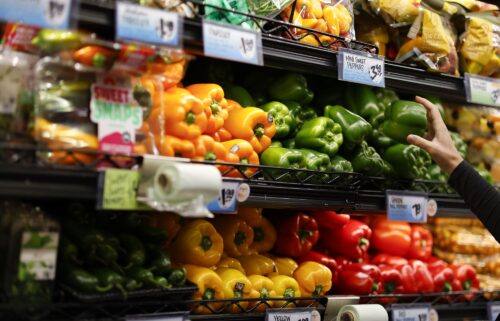What protests in China may mean for the economy
By Nicole Goodkind, CNN Business
Protests against China’s prolonged and restrictive Covid regulations spread across the country over the weekend. The demonstrations against Chinese President Xi Jinping and his costly zero-Covid policy are an exceedingly rare case of widespread civil disobedience.
While the protests represent an unprecedented challenge for Xi, they also carry economic and market implications. Oil plunged and hit 2022 lows on Monday, while shares of companies that rely on China for production felt the heat. Apple fell by 2.6% following reports that unrest at one of its factories could result in 6 million fewer iPhone Pros this year.
What’s happening: China’s controversial zero-Covid policy has affected everyday life and weighed heavily on the economy. When outbreaks get bad enough, entire cities are closed: Shanghai was shut down for about two months this spring and Chengdu, a city of 21 million people, was locked down in the fall.
Earlier this month, Beijing eased some Covid-related restrictions, sparking hopes that the economy could soon fully reopen, but local governments once again tightened controls as cases surged. The policy doesn’t seem to be working, as cases hit record highs, but China’s low vaccination rate, relatively ineffective vaccines and aging population mean the alternative could be very deadly.
The mounting political tension has also been difficult to interpret. The protests at first seemed focused on Covid restrictions, but now appear to carry broader demands for political reform: The blank sheets of paper held up by demonstrators in Shanghai, the country’s financial hub, have already become iconic symbols of defiance against a government that limits free speech.
Economic impact: People under lockdowns say they struggle to find food and other necessities. Economic growth has slumped and unemployment has been been rising as a consequence of the lockdowns.
The policy has also led to major global production constraints that are sustaining inflation. Global supply chain pressures increased moderately in October after five consecutive months of easing, largely due to increases in Asian delivery times, according to the Federal Reserve Bank of New York’s Global Supply Chain Pressure Index.
However, commodities slid on China concerns Monday. Oil prices dropped sharply, with investors concerned that surging Covid cases and protests in China may sap demand from one of the world’s largest oil consumers.
What’s next: Chinese government officials are in a strange spot. They don’t want to end their covid policy but they also want to ensure that the political unrest doesn’t grow. Companies that do business in China are watching closely for any clues about what the future may hold. They’re also considering moving production away from the country in the long term — Apple has already shifted some of its manufacturing to India.
Goldman Sachs, in a research report published late on Sunday, predicted that protests could lead China to scrap its zero-Covid policy earlier than previously expected, with “some chance of a forced and disorderly exit.”
But the next few days could be pivotal. If protests flare up again, the Chinese government will likely be forced to react in some way. On Tuesday, it announced an “action plan” to boost vaccination rates among the elderly. But “with a rapid spread of new COVID cases, it’s hard to envision a broad lifting of restrictions that would boost the country’s economic outlook for next year significantly,” said Christopher Smart, chief global strategist at Baring. “In any case, the continuing uncertainty of pandemic policy will lead to further pressures on global supply chains and keep prices higher than they would otherwise be.”
Big data week
US investors took a short break from the trading floor last week as they celebrated the Thanksgiving holiday. Now, the vacation is definitely over. This week is chock full of important economic data releases, many of which will help guide the Fed’s next interest rate hike decision in December.
Here’s what to keep an eye out for.
Tuesday brings a housing bonanza: At 9 a.m. ET the September House Price Index (HPI), a measure of the change in single-family house prices, is due out. The September S&P/Case-Shiller House Price Index, which measures the change in the selling price of single-family homes in 20 metropolitan areas across the United States, is also due out.
Also on Tuesday: The Conference Board’s November measure for the level of consumer confidence in economic activity. That’s a leading indicator as it can predict consumer spending.
Wednesday is a big Fed day: Federal Reserve Chair Jerome Powell will discuss the economy and labor market at an event hosted by the Brookings Institution at 1:30 p.m. ET. A question and answer session with the audience is also expected. Traders will closely watch his speech for hints about future monetary policy.
Fed Governor Lisa Cook will also discuss the economic outlook and monetary policy at an event hosted by the Detroit Economic Club, and Fed Governor Michelle Bowman will discuss the future of small banks, with a question and answer session afterward.
More data: Wednesday also brings some employment data. First up is The ADP National Employment Report, a measure of the monthly change in private employment, based on the payroll data of approximately 400,000 US business clients. Next comes October JOLTS, a survey by the US Bureau of Labor Statistics to measure job vacancies.
Revised numbers for third-quarter GDP and PCE inflation are also expected out and October Pending Home Sales which measures the change in the number of homes under contract to be sold.
Thursday is all about inflation: October’s Personal Consumption Expenditure Price Index is expected at 8:30 a.m. ET. The index measures changes in the price of goods and services purchased for consumption. Core PCE, which excludes gas and food, is the Fed’s preferred inflation measure.
Friday is jobs day: Here comes government unemployment numbers for November. Given that full employment is one of the Federal Reserve’s mandates, it is very closely watched.
Chicken is on the menu this holiday season
Expect heavier holiday promotions this season, say Bank of America analysts. Why? Retailers are dealing with an excess of inventory they’re trying to get rid of, but it also comes down to timing.
Last year, Americans did their holiday shopping earlier in the year because they were worried about shortages and because the Omicron Covid wave kept people out of stores ahead of the holidays. This year things are expected “to mimic a normal pre-pandemic holiday,” wrote the analysts, with the exception of one thing: There’s an additional day between Thanksgiving and Christmas this year because Christmas Eve falls on a Saturday.
“We think this will likely result in a frenzied game of chicken, with shoppers waiting until the very last minute for great deals and retailers balancing selling at the highest price with moving through enough product,” said Lorraine Hutchinson, a research analyst at Bank of America.
The-CNN-Wire
™ & © 2022 Cable News Network, Inc., a Warner Bros. Discovery Company. All rights reserved.


